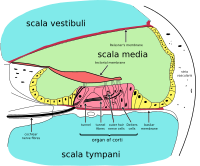
Photo from wikipedia
The presence and edge frequency, fe, of a dead region in the cochlea can be diagnosed using psychophysical tuning curves (PTCs). When the signal frequency, fs, falls in a dead… Click to show full abstract
The presence and edge frequency, fe, of a dead region in the cochlea can be diagnosed using psychophysical tuning curves (PTCs). When the signal frequency, fs, falls in a dead region, the tip of the PTC lies close to fe, rather than close to fs. However, measurement of PTCs is time consuming, limiting their application in clinical practice. We have developed a fast test based on Bayesian active learning. Instead of estimating an entire PTC, we estimate parameters of an individual hearing model, including fe. The task is to detect a fixed signal in the presence of a masker whose level and frequency vary across trials. After each trial, the next masker level and frequency are chosen to produce maximum reduction of the uncertainty about the parameters. The results for four participants tested so far were close to those obtained using “fast” PTCs. The Bayesian procedure has two advantages compared to PTCs: it allows quantification of the reliability of the subjects, estimated from the standard deviation of a ...
Journal Title: Journal of the Acoustical Society of America
Year Published: 2017
Link to full text (if available)
Share on Social Media: Sign Up to like & get
recommendations!